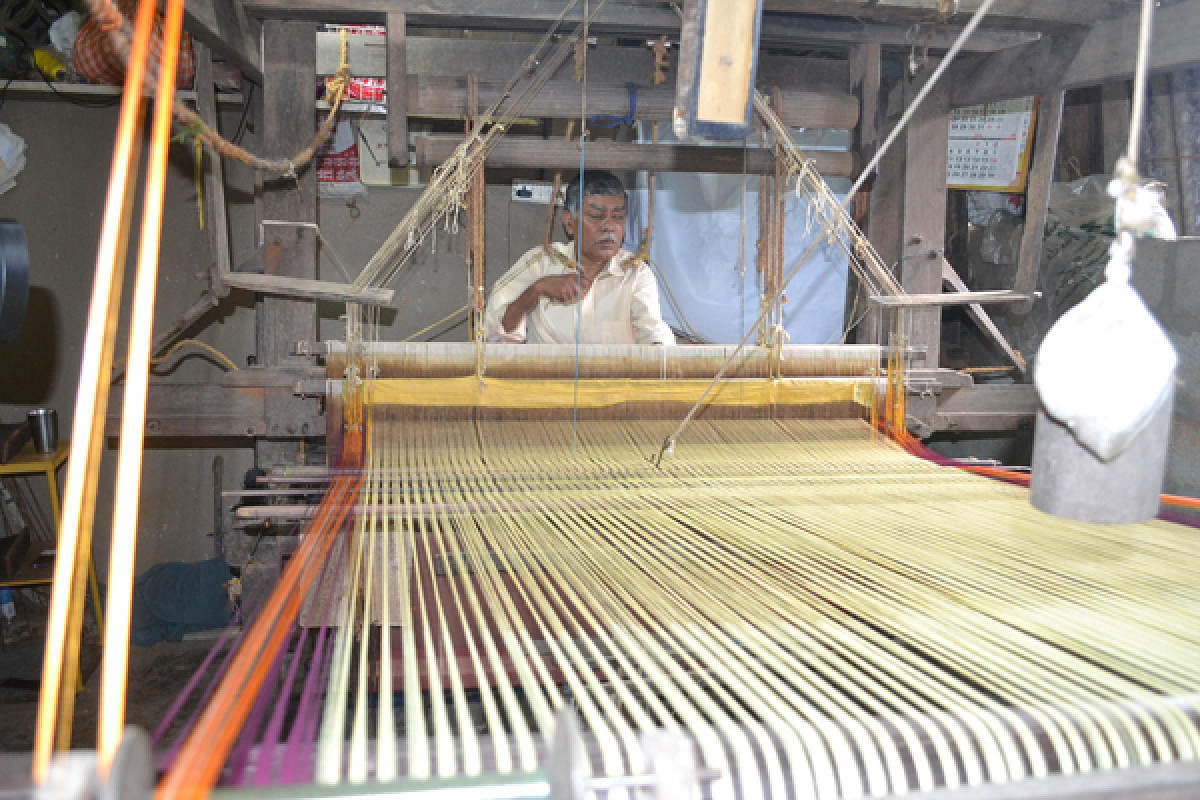
Handlooms are an eternal component of the cultural heritage of the country. The aesthetic symbolism hidden in the beauty of the spun yarn is, in fact, the ultimate embodiment of the cultural aroma of traditional society.
The element of art and craft present in the handlooms makes it a potential sector for the domestic and global market. Despite the sector being plagued by multiple problems, some products have stood the test of time and one such product is Udupi saris.
Udupi handloom is unparalleled in its flexibility and versatility, permitting experimentation and encouraging innovation. The beauty of these saris lies in innovative designs, which cannot be replicated by the saris woven in the power looms. Considering the uniqueness in design and making, Udupi sari was given the Geographical Indication (GI) tag in 2016.
Artistic designs
The speciality of this sari is that it is made of pure cotton with artistic silk design on the border and aesthetic patterns on the pallu. These saris are available in both 80x80 and 60x60 counts. The thread count determines the quality and thickness of the sari. The weight of the sari is less if the count is high.
Strong thread is used in the making of the saris. White thread is boiled in caustic soda and soap to clear the germs and dirt. Further, the thread is rinsed in cold water and an equal amount of colour is added. The rolls of thread are again washed, dipped in starch and left to dry. The body of the sari is usually light coloured and the pallu is dark.
The handloom industry of Udupi and Dakshina Kannada holds the reputation of using the best quality combed cotton yarn. The warp is prepared by using the tie and dye method. The entire warp of the sari is dyed with one colour and the pallu is dyed with another colour and the rest of the warp yarn is tied using rubber tubes.
The ‘loom sizing’ is a unique practice used while making Udupi saris. It is a process of adding the natural starch solution to the warp to strengthen it against the pressure of the reeds. The sizing material is directly applied to the yarn in the weaving process. The sizing material is added to that portion of warp yarn that is about to pass through the healds and reeds.
Rice and maize are generally used as sizing materials. Sizing increases the quality of weaving and decreases the possibility of yarn breakage. This procedure of sizing provides unusual stiffness and shine to the finished saris.
Yet another important aspect of Udupi saris is the cut border technique used to create solid borders. One colour is used for the pallu and border, and another for the body portion. Therefore, three shuttles are used in this process — two shuttles for the pallu and border and one for the body portion. This technique is usually used in the manufacture of check saris. These soft cotton saris that drape beautifully are available at an affordable price.
However, walking down the streets of Udupi today, we don’t hear the familiar sound of weaving. Gone are the days when the streets of the town smelled of pure cotton and the sound of handlooms dominated the air. Clearly, the number of weavers in the temple town is declining.
Three decades ago, the town had about 3,000 handlooms but today only 30 weavers are estimated to be active in the district. The production has fallen but the demand is on the rise.
The Udupi Primary Weavers’ Service Cooperative Society, which would accommodate around 500 weavers about 35 years ago, now has only 18, most of whom are above the age of 60, says the managing director of the society, Sadanand Kanchan.
He says that the younger generation is moving away from the tradition as they can only earn Rs 300 to Rs 400 per day from this. There are other occupations where people are better paid when compared to the weaving industry. However, initiatives are on to preserve and promote Udupi saris.
Better awareness
The demand has risen as there is a greater level of awareness about the comfort offered by Udupi saris. Hence, not only older women but the younger generation is also drawn towards Udupi handloom saris.
Weaver Vasudev Shettygar who is in his 60s feels that there would no weavers in the district in the next decade. The occupation is finding it hard to endure as the income earned is not sufficient to make the ends meet.
Known for their lightness and elegance, Udupi saris are used both as daily wear and formal wear. Sujala Nayak who is in her mid-30s adds that these saris which come in fusion colours along with the normal colour combination are simple and can be worn without much difficulty. She said that these saris once ironed will remain so until the next wash. Of course, it has the ethnic touch of the culture and tradition of the area, she said.